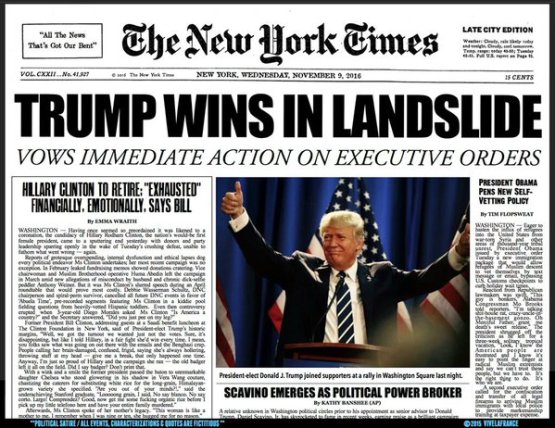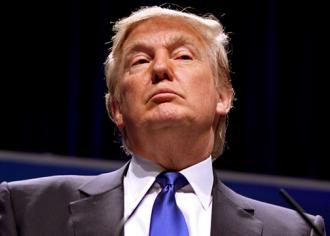 We all know very well by now that the white working class did not cause Trump to win the elections. Article after article have made the case, typically pointing to Nate Silver’s finding that the median household income of Trump supporters in the Republican primary was $72,000, roughly $10,000 more than the median household income for all whites. In the general election, Clinton won the majority of all voters earning $50,000 or less. Trump supporters are many things. They are undoubtedly whiter. They are also less likely to be educated and more likely to work in blue-collar jobs. But there’s one thing they’re not: overwhelmingly working-class.
We all know very well by now that the white working class did not cause Trump to win the elections. Article after article have made the case, typically pointing to Nate Silver’s finding that the median household income of Trump supporters in the Republican primary was $72,000, roughly $10,000 more than the median household income for all whites. In the general election, Clinton won the majority of all voters earning $50,000 or less. Trump supporters are many things. They are undoubtedly whiter. They are also less likely to be educated and more likely to work in blue-collar jobs. But there’s one thing they’re not: overwhelmingly working-class.
Trump, Liberalism and the White Working Class
A Diary of Protest for the Days to Come
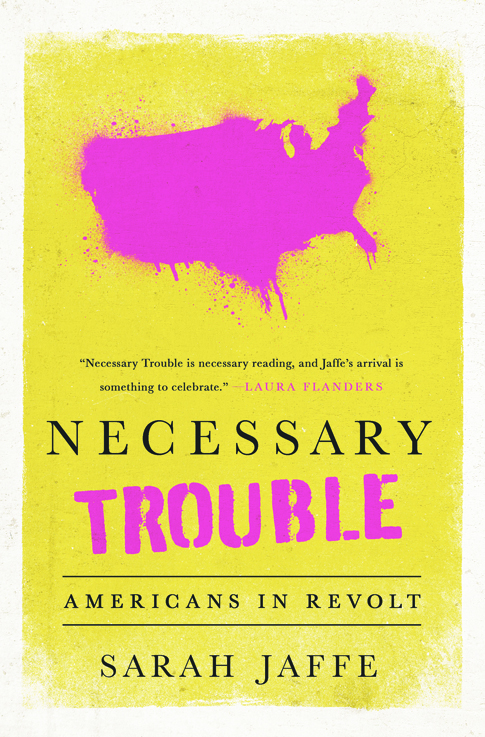
Sarah Jaffe. Necessary Trouble: Americans in Revolt. New York: Nation Books, 2016. 352pp. $26.99
One might be tempted to read Sarah Jaffe’s book with a kind of archaeological nostalgia, to look upon it as a remnant of a bygone-era when the left had confidence in the gains it was making, before a meteor named Trump struck earth.
Mazzocchi and the Moment
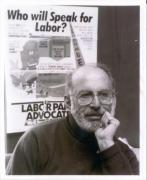
In recent months I’ve been thinking a lot, more than usual, of Anthony Mazzocchi, longtime official of the Oil, Chemical, and Atomic Workers International Union, leading presence in the movement for occupational health and safety, and one of the very brightest lights of a serious working-class politics in the post-World War II era until his too-early death in 2002. Tony often observed, regarding capital’s revanchist attack on working people that has steadily intensified over the last four decades, that what we would now call the neoliberal Democrats had nothing to offer those who have been or fear being ground into the dust by the juggernaut. He cautioned that, if the left and the labor movement didn’t find ways to connect with that growing population of those hurting and to offer credible explanations of the sources of their condition and plausible strategies for fighting back, other, nasty and dangerous tendencies would. That perspective reflected a deeper view of politics that guided the thousands of us who, for nearly all the 1990s and most of the first decade of this century, struggled to articulate and advance an unambiguously working-class politics through the effort to build an independent Labor Party, of which Tony was the “Founding Brother” and animating force. In the 2015 issue of the Socialist Register, Mark Dudzic and I laid out an assessment of the state of the left and labor movement in the U.S. and the challenges that face us that is rooted in that perspective.
The Banality of Evil: Elites Close Ranks Behind Trump
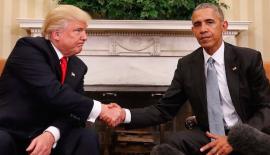
Happy Thanksgiving! As we celebrate the America’s founding myth of the Pilgrim Fathers welcomed by the Indians, the National Guard, militarized local police and (unlicensed) security guards continue to brutalize unarmed Standing Rock Sioux Indians (and members of dozens of other tribes) protesting the construction of the unapproved Dakota Access Pipeline on their sacred lands and water sources.[1]
Reflections on the Election

Post-election left analyses have accurately identified many of the immediate causes for our current debacle. Voter suppression, the Electoral College, the Democratic Party, the Clinton campaign, Hillary Clinton, labor leaders, hacked emails, FBI chief James Comey, Democratic primary voters who voted for Clinton, minority voters who didn’t turn out in sufficient numbers — the list goes on. And all of these deserve blame. But I’ve seen very little self-reflection from the left. There have been some vigorous defenses of left actions, but little self-criticism and little to suggest that the same mistakes won't be repeated again.
Should Greens Go Local?

As Kermit the Frog, America’s most famous Muppet, says: “it’s not easy being green.”
Preliminary results of the Green Party’s latest national campaign confirm the reality of his observation. The Party’s much-touted goal was getting 5% of the vote on Nov. 8, so it could qualify for $10 million in federal funds for 2020 campaigning and maintain broad nationwide ballot access.
We Fight for Socialism over Barbarism
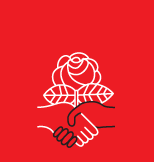
How Trump Won: Seizing the Anti-Establishment Ground through Racial and Economic Nationalism
On November 8, voters in the United States narrowly elected an openly racist, misogynist and nativist candidate for president. Donald Trump succeeded in defining himself as an anti-establishment candidate who will end dynastic rule in Washington, D.C., by elites who care little for “forgotten Americans.”
The election of Trump and the struggle ahead

1. The election of Donald Trump as president of the United States is a shocking and dangerous turn of events–not only for the U.S., but for the entire world. It is a decisive shift, representing the latest failure of center-right and center-left parties in the advanced capitalist countries in the wake of the Great Recession, opening the way for the triumph of a candidate who used right-wing populism to stoke racism, xenophobia and reaction.
Mass Incarceration and Its Mystification: A Review of "The 13th"
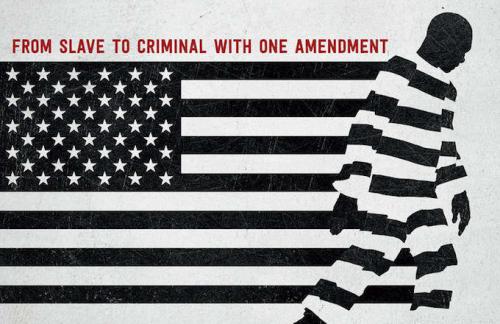
When prisoners in Alabama last spring proposed a national strike to protest “prison slavery,” they called out the infamous clause in the Thirteenth Amendment. The amendment most known for abolishing slavery included a rider that sanctioned slavery “as punishment for a crime wherein the party shall have been duly convicted.”
Build the Left to Defeat the Right

Like millions of people here and around the world, we woke up this morning dismayed and frightened that Donald Trump has been elected President. Whatever we each thought of the Democratic Party and of Hillary Clinton, none of us wanted to believe that a plurality of voters could bring themselves to vote for Trump. His victory is part of a global pattern of an ascendant, populist right, following in the wake of the similarly unexpected vote in favor of Brexit in the UK, and, like Brexit, it is being celebrated by right wing nationalist leaders in Europe like Marine Le Pen.
Solidarity with the Standing Rock Sioux and all the Struggles of Indigenous Peoples

The Black Workers for Justice support the struggles of the indigenous peoples to defend their land and treaty rights and their struggles for environmental justice. And in this moment we are in full support of the resistance of the Standing Rock Sioux to the construction of the Dakota Access Pipeline (DAPL). We call on all people to support them politically and materially.
Third Parties—My Personal Experience
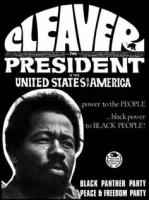
I joined the Peace and Freedom Party under the guidance of leaders of the International Socialists (IS), including Mike Parker and Jack Weinberg, in 1967-68. This was my only real involvement in a third party. It was not only long ago, it was a different context: there was a large, lively left movement, which at the time appeared to be still growing (we hoped).
Thus the P & F was conceived of—and briefly was—a movement party. That’s why it may be worth a look back.
To get the party on the ballot in California, we had to get people to change their party registration, via a registrar, often from Democratic, to P & F. Some 107,000 did so in California, which was remarkable. The same year George Wallace used the same procedure to get an almost exact number of registrants for his party.
I recall an IS member, J.B., said to me “I just wish we had his demographics!” So true.
Who Would You Vote for in 1840? And Who Will You Vote for on Nov. 8?
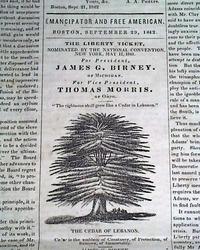
Imagine that it is 1840 and someone approaches you on the street and hands you a flyer for James G. Birney, the presidential candidate of the new Liberty Party. The flyer says that the Liberty Party opposes slavery. It is the only party that does.
The Democrats and the Whigs–the two parties of the two-party system of that time–supported slavery, not to the same degree perhaps, but neither party opposed slavery. The Liberty Party is new and small, tiny. It’s candidate Birney has absolutely no chance to win the election. But he stands opposed to slavery. Who will you vote for on voting day in 1840?
A Solid Trump Exposé That Gives Hillary a Pass
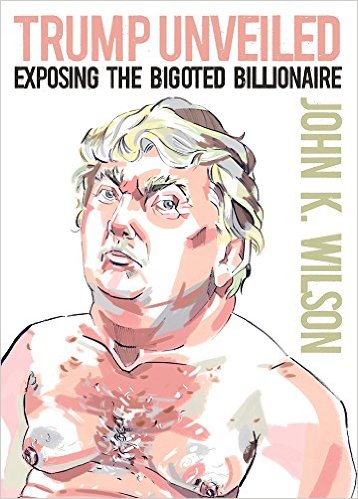
John K. Wilson. Trump Unveiled: Exposing the Bigoted Billionaire. New York: OR Books, 2016. 256 pp.
November 8 is show time. What will the time tell? The egregious Hillary Rodham Clinton will likely be elected president over the menacing tin pot Donald Trump. Clinton may be the shoddy Brand X, but corporate capital will sleep soundly in its bed with a Clinton presidency and even a Democratic Senate. Working families will be screwed again, but with more finesse than under a solipsistic Trump diktat. Sure, Hillary’s evasions and saccharine pronouncements pale in comparison to Trump’s Orwellianisms, his fabrications and the unsubtle subtext of his real stance, to “Make America White again.” No wonder Hillary will win. And by default.
Isn’t political life at the top grand?
President Clinton? 4 Big Battle Lines for Pushing Her to the Left
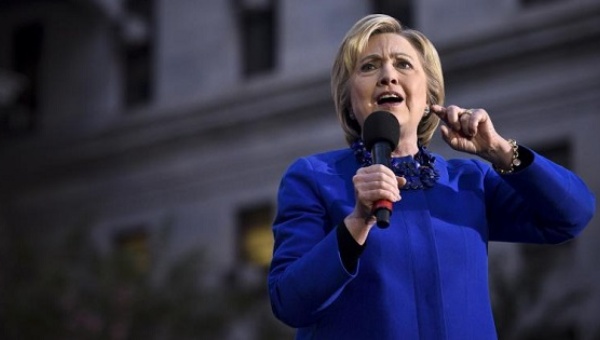 On October 6, 2008, an executive with Citigroup sent John Podesta, then co-chair of Barack Obama’s transition team, a list of possible cabinet appointments. There were still 29 days left in the hard-fought campaign. But the list, according to the New Republic, was almost entirely on the money; for who went on to fill senior posts in the Obama Administration, including Rahm Emanuel as chief of staff, Eric Holder as attorney general, Susan Rice as U.N. ambassador, and Janet Napolitano to lead Homeland Security.
On October 6, 2008, an executive with Citigroup sent John Podesta, then co-chair of Barack Obama’s transition team, a list of possible cabinet appointments. There were still 29 days left in the hard-fought campaign. But the list, according to the New Republic, was almost entirely on the money; for who went on to fill senior posts in the Obama Administration, including Rahm Emanuel as chief of staff, Eric Holder as attorney general, Susan Rice as U.N. ambassador, and Janet Napolitano to lead Homeland Security.
Trump’s Temerism
 The night of the penultimate presidential debate I was at a screening of the Brazilian film Aquarius, which tells the story of a woman fighting a corrupt development company to remain in her apartment building. During the Q&A session with the director and force-of-nature actress Sonia Braga, a handful of demonstrators stood up, silently, holding “Fora Temer” signs to protest the government that has illegally installed itself in Brazil. Within sixty seconds Lincoln Center had the NYPD to escort them out, against Braga’s objections, and the Q&A continued with police watching from the edges of aisles.
The night of the penultimate presidential debate I was at a screening of the Brazilian film Aquarius, which tells the story of a woman fighting a corrupt development company to remain in her apartment building. During the Q&A session with the director and force-of-nature actress Sonia Braga, a handful of demonstrators stood up, silently, holding “Fora Temer” signs to protest the government that has illegally installed itself in Brazil. Within sixty seconds Lincoln Center had the NYPD to escort them out, against Braga’s objections, and the Q&A continued with police watching from the edges of aisles.
Black Liberation and the Abolition of the Prison Industrial Complex

Rachel Herzing lives and works in Oakland, CA, where she fights the violence of policing and imprisonment. She is a co-founder of Critical Resistance, a national grassroots organization dedicated to abolishing the prison industrial complex and the Co-Director of the StoryTelling & Organizing Project, a community resource sharing stories of interventions to interpersonal harm that do not rely on policing, imprisonment, or traditional social services. The following interview was conducted by the True Leap Publishing Collective.
Organizing Prisons in the 1960s and 1970s
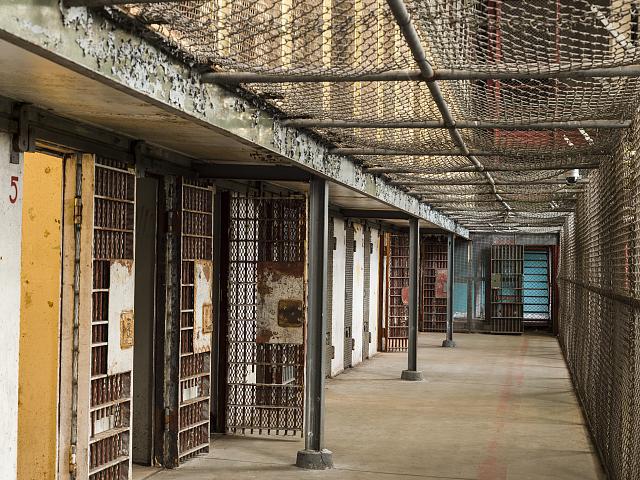
On the 45th anniversary of the Attica Prison rebellion in 1971, Process speaks with seven scholars of the carceral state about prisoners’ organizing in the 1960s and 1970s and movements protesting mass incarceration today. This is the first of a three-part series, guest edited for Process by Jessie Kindig. Check out parts two and three.
Why Is Oscar López Rivera Still A Political Prisoner?
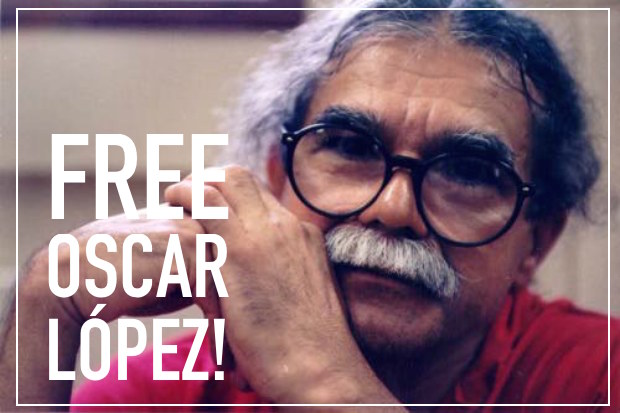
Oscar López Rivera is the longest-held Puerto Rican political prisoner in U.S. history. He has now served 35 years in U.S. federal prisons, including 12 in solitary confinement. The movement calling for his release has intensified, broadened and strengthened in the last few years.
